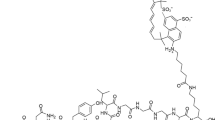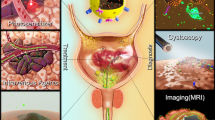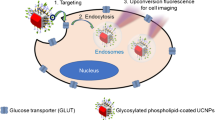Abstract
Background
Bladder cancer is the fifth most common malignancy in humans. Cystoscopy under white light imaging is the gold standard for bladder cancer diagnosis, but some tumors are difficult to visualize and can be overlooked, resulting in high recurrence rates. We previously developed a phage display-derived peptide-based near-infrared imaging probe, PLSWT7-DMI, which binds specifically to bladder cancer cells and is nontoxic to animals. Here, we report a clinical research of this probe for near-infrared fluorescence endoscopic detection of bladder cancer.
Results
The purity, efficacy, safety, and nontoxicity of PLSWT7-DMI were confirmed prior to its clinical application. Twenty-two patients diagnosed with suspected non-muscle invasive bladder cancer were enrolled in the present study. Following intravesical administration of the probe, the entire mucosa was imaged under white and near-infrared imaging using an in-house developed endoscope that could switch between these two modes. The illuminated lesions under near-infrared light were biopsied and sent for histopathological examination. We observed a 5.1-fold increase in the fluorescence intensity in the tumor samples compared to normal tissue, and the probe demonstrated a sensitivity and specificity of 91.2% and 90%, respectively. Common diagnostic challenges, such as small satellite tumors, carcinoma in situ, and benign suspicious mucosa, were visualized and could be distinguished from cancer. Furthermore, no adverse effects were observed in humans. These first-in-human results indicate that PLSWT7-DMI-based near-infrared fluorescence endoscopy is a safe and effective approach for the improved detection of bladder cancer, and may enable thorough resection to prevent recurrence.





Similar content being viewed by others
References
Siegel RL, Miller KD, Jemal A. Cancer statistics, 2018. CA Cancer J Clin. 2018;68(1):7–30.
Pasin E, Josephson DY, Mitra AP, Cote RJ, Stein JP. Superficial bladder cancer: an update on etiology, molecular development, classification, and natural history. Rev Urol. 2008;10(1):31–43.
Carson CC. World Health Organization classification of tumours: pathology & genetics of tumours of the urinary system and male genital organs. Urology. 2005;65(1):213–4.
Jichlinski P, Leisinger H. Fluorescence cystoscopy in the management of bladder cancer: a help for the urologist! Urol Int. 2005;74(2):97–101.
Oliva Encina J, Marco Valdenebro A, Pelegrí Gabarró J, Rioja SC. Beyond the photodynamic diagnosis: searching for excellence in the diagnosis of non-muscle-invasive bladder cancer. Actas Urol Esp. 2010;34(8):657–68.
Sylvester RJ, van der Meijden APM, Oosterlinck W, Witjes JA, Bouffioux C, Denis L, et al. Predicting recurrence and progression in individual patients with stage Ta T1 bladder cancer using EORTC risk tables: a combined analysis of 2596 patients from seven EORTC trials. Eur Urol. 2006;49(3):466–77.
Aboumarzouk O, Valentine R, Buist R, Ahmad S, Nabi G, Eljamel S, et al. Laser-induced autofluorescence spectroscopy: can it be of importance in detection of bladder lesions? Photodiagn Photodyn. 2015;12(1):76–83.
Babjuk M, Burger M, Compérat E, Gontero P, Mostafid AH, Palou J, van Rhijn BWG, Rouprêt M, Shariat SF, Sylvester R, Zigeuner R, Guidelines Associates: Capoun O, Cohen D, Dominguez Escrig JL, Peyronnet B, Seisen T, Soukup V. Guidelines on non-musclie invasive bladder cancer (TaT1 and CIS). EAU. 2020.
Babjuk M, Burger M, Compérat EM, Gontero P, Mostafid AH, Palou J, et al. European Association of Urology guidelines on non-muscle-invasive bladder cancer (TaT1 and carcinoma in situ) - 2019 update. Eur Urol. 2019;76(5):639–57.
Lykke MR, Nielsen TK, Ebbensgaard NA, Zieger K. Reducing recurrence in non-muscle-invasive bladder cancer using photodynamic diagnosis and immediate post-transurethral resection of the bladder chemoprophylaxis. Scand J Urol. 2015;49(3):230–6.
Fradet Y, Grossman HB, Gomella L, Lerner S, Cookson M, Albala D, et al. A comparison of hexaminolevulinate fluorescence cystoscopy and white light cystoscopy for the detection of carcinoma in situ in patients with bladder cancer: a phase III, multicenter study. J Urol. 2007;178(1):68–73.
Grimm M, Steinhoff C, Simon X, Spiegelhalder P, Ackermann R, Vögeli TA. Effect of routine repeat transurethral resection for superficial bladder cancer: a long-term observational study. J Urol. 2003;170(2):433–7.
Chai CA, Yeoh WS, Rajandram R, Aung KP, Ong TA, Kuppusamy S, Nazran A, Kumaran K, Razack AHA, Teoh JY. Comparing CxBladder to urine cytology as adjunct to cystoscopy in surveillance of non-muscle invasive bladder cancer-a pilot study. Front Surg. 2021;8:659292.
Beji S, Lam GW, Ostergren PB, Toxvaerd A, Sonksen J, Fode M. Diagnostic value of probe-based confocal laser endomicroscopy versus conventional endoscopic biopsies of non-muscle invasive bladder tumors: a pilot study. Scand J Urol. 2021;55(1):36–40.
Rouanne M, Betari R, Radulescu C, Goubar A, Signolle N, Neuzillet Y, et al. Stromal lymphocyte infiltration is associated with tumour invasion depth but is not prognostic in high-grade T1 bladder cancer. Eur J Cancer. 2019;108:111–9.
Daneshmand S, Bazargani ST, Bivalacqua TJ, Holzbeierlein JM, Willard B, Taylor JM, et al. Blue light cystoscopy for the diagnosis of bladder cancer: results from the US perspective multicenter registry. Urol Oncol. 2018;36(8):361.e1-361.e6.
Drejer D, Beji S, Oezeke R, Nielsen AM, Hoyer S, Johansen TEB, et al. Comparison of white light, photodynamic diagnosis, and narrow-band imaging in detection of carcinoma in situ or flat dysplasia at transurethral resection of the bladder: the DaBlaCa-8 study. Urology. 2017;102:138–42.
Rink M, Babjuk M, Catto JWF, Jichlinski P, Shariat SF, Stenzl A, et al. Hexyl aminolevulinate–guided fluorescence cystoscopy in the diagnosis and follow-up of patients with non–muscle-invasive bladder cancer: a critical review of the current literature. Eur Urol. 2013;64(4):624–38.
Schraml J, Silva JDC, Babjuk M. Current concept of transurethral resection of bladder cancer: from re-transurethral resection of bladder cancer to en-bloc resection. Curr Opin Urol. 2018;28(6):591–7.
Liu J, Droller MJ, Liao JC. New optical imaging technologies for bladder cancer: considerations and perspectives. J Urol. 2012;188(2):361–8.
Wiesner C, Jäger W, Salzer A, Biesterfeld S, Kiesslich R, Hampel C, et al. Confocal laser endomicroscopy for the diagnosis of urothelial bladder neoplasia: a technology of the future? BJU Int. 2011;107(3):399–403.
Gladkova N, Streltsova O, Zagaynova E, Kiseleva E, Gelikonov V, Gelikonov G, et al. Cross-polarization optical coherence tomography for early bladder-cancer detection: statistical study. J Biophotonics. 2011;4(7–8):519–32.
Mahalingam SM, Dudkin VY, Goldberg S, Klein D, Yi F, Singhal S, et al. Evaluation of a centyrin-based near-infrared probe for fluorescence-guided surgery of epidermal growth factor receptor positive tumors. Bioconjug Chem. 2017;28(11):2865–73.
James ML, Gambhir SS. A molecular imaging primer: modalities, imaging agents, and applications. Physiol Rev. 2012;92(2):897–965.
Peng L, Shang W, Guo P, He K, Wang H, Han Z, et al. Phage display-derived peptide-based dual-modality imaging probe for bladder cancer diagnosis and resection postinstillation: a preclinical study. Mol Cancer Ther. 2018;17(10):2100–11.
Benias PC, Wells RG, Sackey-Aboagye B, Klavan H, Reidy J, Buonocore D, Miranda M, Kornacki S, Wayne M, Carr-Locke DL, Theise ND. Structure and distribution of an unrecognized interstitium in human tissues. Sci Rep. 2018;8(1):4947.
Bourn J, Rathore K, Donnell R, White W, Uddin MJ, Marnett L, Cekanova M. Detection of carcinogen-induced bladder cancer by fluorocoxib A. BMC Cancer. 2019;19(1):1152.
Schmidt A, Sommer F, Reiner M, Klotz T, Engelmann U, Addicks K, Bloch W. Differential endostatin binding to bladder, prostate and kidney tumour vessels. BJU Int. 2005;95(1):174–9.
Zupančič D, Kreft ME, Sterle I, Romih R. Combined lectin- and immuno-histochemistry (CLIH) for applications in cell biology and cancer diagnosis: analysis of human urothelial carcinomas. Eur J Histochem. 2020;64(3):3141.
Inoue K. 5-Aminolevulinic acid-mediated photodynamic therapy for bladder cancer. Int J Urol. 2017;24(2):97–101.
Feng Z, Yu X, Jiang M, Zhu L, Zhang Y, Yang W, Xi W, Li G, Qian J. Excretable IR-820 for in vivo NIR-II fluorescence cerebrovascular imaging and photothermal therapy of subcutaneous tumor. Theranostics. 2019;9(19):5706–19.
Huang J, Jiang Y, Li J, He S, Huang J, Pu K. A renal-clearable macromolecular reporter for near-infrared fluorescence imaging of bladder cancer. Angew Chem Int Ed Engl. 2020;59(11):4415–20.
Shen P, Yang J, Wei W, Li Y, Li D, Zeng H, et al. Effects of fluorescent light-guided transurethral resection on non-muscle-invasive bladder cancer: a systematic review and meta-analysis. BJU Int. 2012;110(6b):E209–15.
Witjes JA, Babjuk M, Gontero P, Jacqmin D, Karl A, Kruck S, et al. Clinical and cost effectiveness of hexaminolevulinate-guided blue-light cystoscopy: evidence review and updated expert recommendations. Eur Urol. 2014;66(5):863–71.
Burggraaf J, Kamerling IMC, Gordon PB, Schrier L, de Kam ML, Kales AJ, et al. Detection of colorectal polyps in humans using an intravenously administered fluorescent peptide targeted against c-Met. Nat Med. 2015;21(8):955–61.
Foersch S, Kiesslich R, Waldner MJ, Delaney P, Galle PR, Neurath MF, et al. Molecular imaging of VEGF in gastrointestinal cancer in vivo using confocal laser endomicroscopy. Gut. 2010;59(8):1046–55.
Hattori S, Kojima K, Minoshima K, Yamaha M, Horie M, Sawamura T, Kikuchi A, Deguchi T. Detection of bladder cancer by measuring CD44v6 expression in urine with real-time quantitative reverse transcription polymerase chain reaction. Urology. 2014;83(6):1443.
Goetz M, Wang TD. Molecular imaging in gastrointestinal endoscopy. Gastroenterology. 2010;138(3):828–33.
Quan YH, Oh CH, Jung D, Lim JY, Choi BH, Rho J, Choi Y, Han KN, Kim BM, Kim C, Park JH, Kim HK. Evaluation of intraoperative near-infrared fluorescence visualization of the lung tumor margin with indocyanine green inhalation. JAMA Surg. 2020;155(8):732–40.
Naselli A, Introini C, Bertolotto F, Spina B, Puppo P. Narrow band imaging for detecting residual/recurrent cancerous tissue during second transurethral resection of newly diagnosed non-muscle-invasive high-grade bladder cancer. BJU Int. 2010;105(2):208–11.
Sturm MB, Joshi BP, Lu S, Piraka C, Khondee S, Elmunzer BJ, et al. Targeted imaging of esophageal neoplasia with a fluorescently labeled peptide: first-in-human results. Sci Transl Med. 2013;5(184):184ra61.
Pan Y, Volkmer J, Mach KE, Rouse RV, Liu J, Sahoo D, et al. Endoscopic molecular imaging of human bladder cancer using a CD47 antibody. Sci Transl Med. 2014;6(260):260ra148.
Golijanin J, Amin A, Moshnikova A, Brito JM, Tran TY, Adochite R, et al. Targeted imaging of urothelium carcinoma in human bladders by an ICG pHLIP peptide ex vivo. Proc Natl Acad Sci U S A. 2016;113(42):11829–34.
Riedl CR, Daniltchenko D, Koenig F, Simak R, Loening SA, Pflueger H. Fluorescence endoscopy with 5-aminolevulinic acid reduces early recurrence rate in superficial bladder cancer. J Urol. 2001;165(4):1121–3.
Gosnell ME, Polikarpov DM, Goldys EM, Zvyagin AV, Gillatt DA. Computer-assisted cystoscopy diagnosis of bladder cancer. Urol Oncol. 2018;36(1):8. e99-8. e15.
Stenzl A, Penkoff H, Dajc-Sommerer E, Zumbraegel A, Hoeltl L, Scholz M, Riedl C, Bugelnig J, Hobisch A, Burger M, Mikuz G, Pichlmeier U. Detection and clinical outcome of urinary bladder cancer with 5-aminolevulinic acid-induced fluorescence cystoscopy: a multicenter randomized, double-blind, placebo-controlled trial. Cancer. 2011;117(5):938–47.
Author information
Authors and Affiliations
Contributions
Wenting Shang and Li Peng wrote the manuscript, in addition to designing, performing, and analyzing all experiments. Wenting Shang synthesized and characterized the probe. Kunshan He designed the imaging system. Pengyu Guo assisted with collecting the information on NMIBC patients. Han Deng assisted with the manuscript modification. Yu Liu assisted with the data analysis. Jie Tian and Wanhai Xu designed, supervised, and analyzed all experiments, in addition to assisting with the manuscript preparation.
Corresponding authors
Ethics declarations
Conflict of interest
The authors declare no competing interests.
Additional information
Publisher's note
Springer Nature remains neutral with regard to jurisdictional claims in published maps and institutional affiliations.
Wenting Shang, Li Peng, Kunshan He, and Pengyu Guo are the parallel first authors.
This article is part of the Topical Collection on Translational research.
Supplementary Information
Below is the link to the electronic supplementary material.
Rights and permissions
About this article
Cite this article
Shang, W., Peng, L., He, K. et al. A clinical study of a CD44v6-targeted fluorescent agent for the detection of non-muscle invasive bladder cancer. Eur J Nucl Med Mol Imaging 49, 3033–3045 (2022). https://doi.org/10.1007/s00259-022-05701-3
Received:
Accepted:
Published:
Issue Date:
DOI: https://doi.org/10.1007/s00259-022-05701-3




